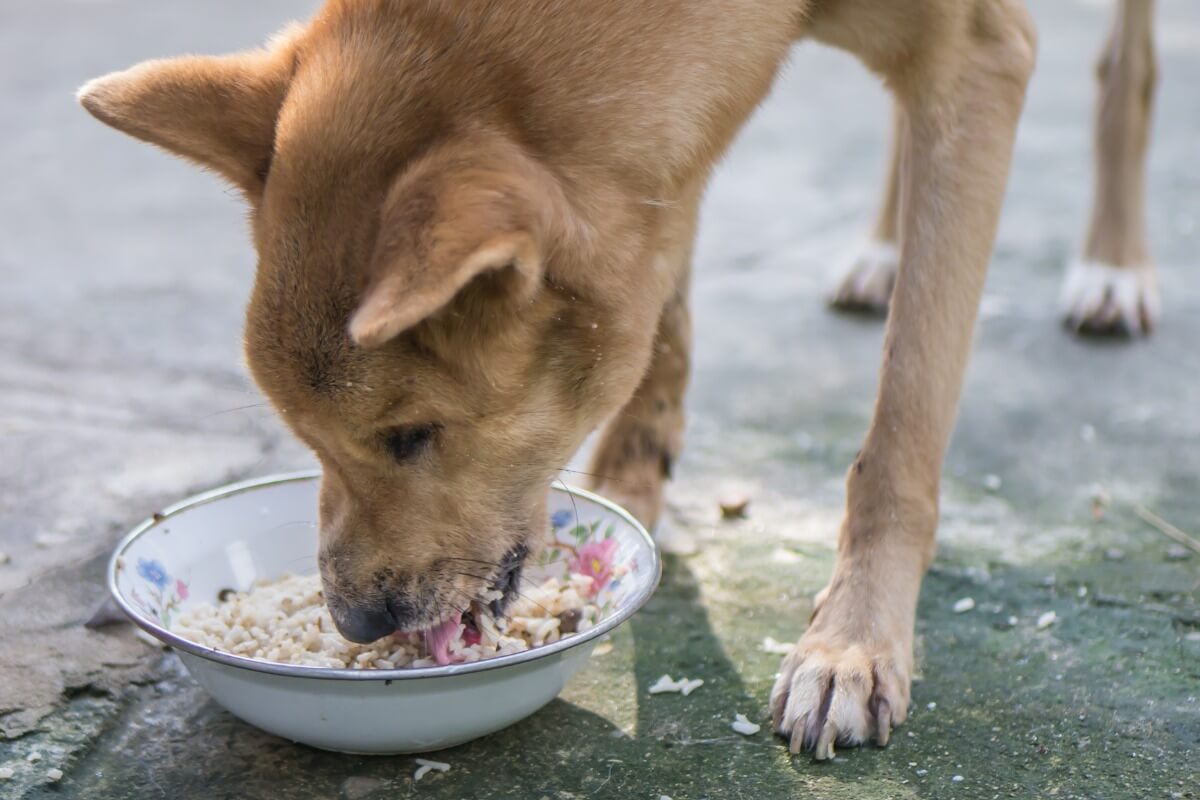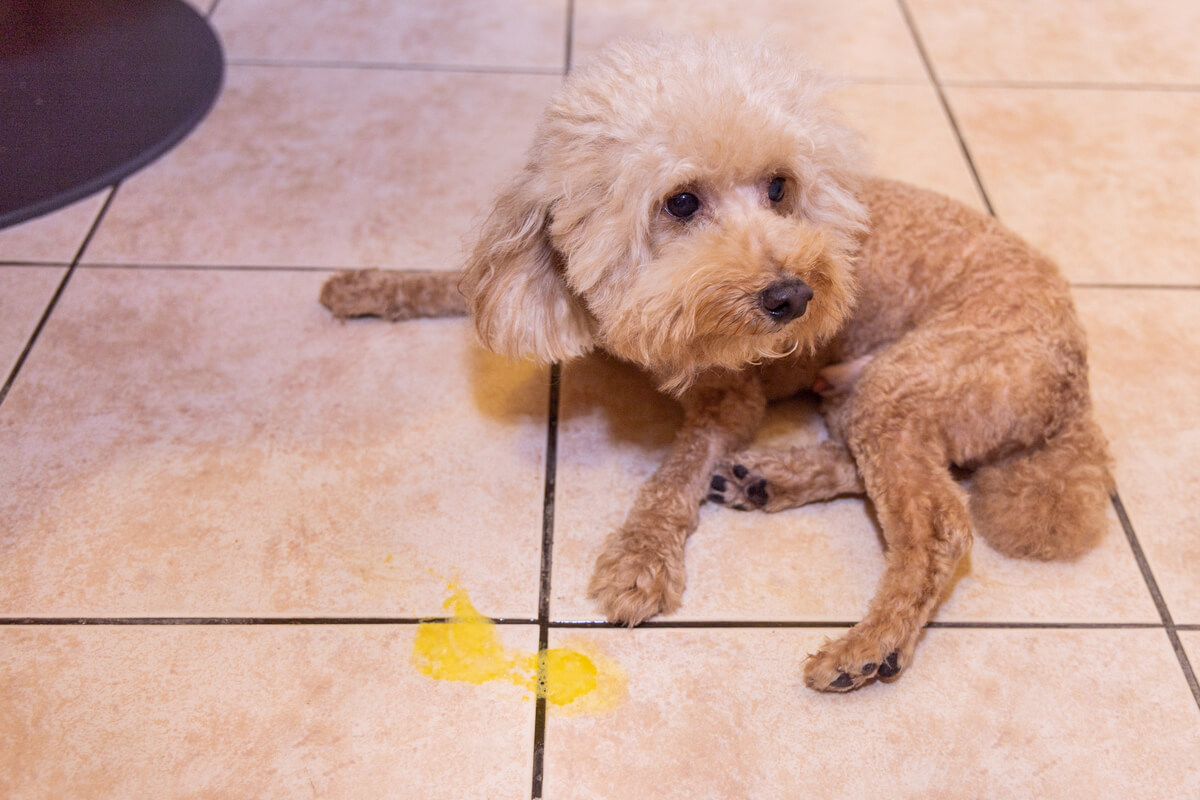Why Does My Dog Bring Up Green Vomit?


Written and verified by the biologist Samuel Sanchez
Dogs are curious and inquisitive animals by nature. Because of that, quite often they’ll ingest poisoned food or eat things they shouldn’t. You may be startled by seeing your dog bring up green vomit. It may be normal, but if your dog has green vomit, you should take it to your vet to get an accurate diagnosis.
Dog vomit can tell a lot about what they just ate, but also about their health and possible underlying pathologies. If your canid has just regurgitated a green substance and it worries you, here we’ll tell you everything you need to know about the subject.
A dog’s digestive system
A dog’s digestive system includes all the organs in charge of food processing. The food journey begins in the mouth, continues in the esophagus, and then the stomach, liver, intestines, pancreas, and finally the rectum and anus are involved in its processing.
The digestive functions of the canine gastrointestinal tract —and of all vertebrates— can be summarized in 4 points. They’re the following:
- Digestion: This is the process of transformation by hydrolysis of food into particles small enough to pass through the plasma membrane. Various enzymes (proteases, lipases, amylases, etc.) are responsible for the breakdown of macronutrients. By-products are converted into energy or become part of tissues.
- Nutrient absorption: In this process, nutrients cross gastric barriers and are incorporated into the bloodstream. From there, they pass into the tissues and nourish the cells.
- Motility: Thanks to the contractions of the smooth muscles, the food can pass through the intestines. In them, water, nutrients, and many other useful compounds are reabsorbed.
- Excretion: Dog feces contain all the elements that the body can’t use. They also carry bacteria and other elements of the gut microbiota.
In a normal situation, wet food travels all the way through the gastrointestinal tract in about 4 to 5 hours, while dry food takes a little longer – 8 to 12 hours. Unfortunately, there are various pathologies that can interrupt the proper functioning of this system.

Why does a dog have green vomit?
Before addressing this issue, we need to emphasize that vomiting and regurgitation aren’t the same. When a canid regurgitates, it’s expelling food or compounds that had become stuck in its tracheal area or mouth. It’s a fairly common act and is rarely an indication of a problem. In these cases, the regurgitated item is chewed, but hasn’t yet been mixed with gastric juices.
On the other hand, vomiting is more serious, as the canid is emptying its gastric contents in a more “internal” way. When this happens, the canid’s abdominal muscles can be seen contracting, and gagging is common. We’ll now explore why a dog can have green vomit.
Green vomit from ingestion of grass
Chlorophylls are a set of pigments that give plants the green coloration on their leaves. Dogs sometimes eat grass to include fiber in their diet, essential for maintaining the gut microbiota – a collection of symbiotic microorganisms.
On the other hand, the American Kennel Club emphasizes that canids also eat vegetables to induce vomiting and relieve intestinal discomfort. However, less than 25% of dogs vomit after eating grass and only 10% show signs of illness before consuming it. In other words, dogs eat grass more for deficiencies or boredom than to induce vomiting.
Be that as it may, when a dog eats grass or other vegetables with chlorophyll it can being up green vomit. If this happens only from time to time, it shouldn’t be a serious problem. However, if this is repeated over time, then it’s necessary to go to the vet.
Green vomit from the presence of bile
Yellow-green vomit in dogs can also indicate that their stomach is empty. The coloration in these cases is due to bile, a fluid that’s synthesized in the liver and stored in the gallbladder, and then released into the intestinal environment. Bile salts, proteins, cholesterol, hormones, and water give bile its characteristic greenish color.
If the dog vomits bile on an empty stomach, a visit to the vet is necessary, as it isn’t a normal physiological event. Here are 5 potential causes:
- Bilious vomiting syndrome (BLS): With this condition, bile “rises” from the small intestine to the stomach. It can be caused by physiological defects or by a diet based on too fatty foods, among other things.
- Gastrointestinal diseases: From cancers to chronic intestinal syndromes, many conditions can lead to the vomiting of bile.
- Pancreatitis: Chronic inflammation of the pancreas causes the canid to vomit, and have nausea, fever, abdominal pain, and other conditions. When the sick animal vomits repeatedly, the stomach’s contents empty and it ends up ejecting bile.
- Intestinal blockages: The dog may have consumed an element that’s impossible to digest. Intestinal blockages cause repeated vomiting, which is why bile ends up also coming out.
- Allergies:- Dogs can also vomit repeatedly from food allergies.
If the dog brings up green vomit from the continuous release of bile, you should go to the vet with them. Stomach acids can cause irreversible damage to the esophagus and mouth, so don’t waste any time.
Infectious diseases
If your dog vomits for more than 24 hours in a row, they’re most likely suffering from a viral, bacterial, or parasitic enteric infection. Vomit can also appear green by the same mechanism mentioned above: if its stomach contents are emptied, the next thing that comes out is bile, which is greenish in color.
Gastrointestinal infections can also manifest with listlessness, fever, general weakness, and other clinical signs.
Chemical poisonings
Some chemical compounds are green in color, either due to the addition of dyes or due to the nature of the elements present. If your dog ingests a chemical of this color, the most normal thing is that it’ll bring it back up with its original hue, as it’s something that it has not been able to digest.
When a dog suffers chemical poisoning, in addition to vomiting, it can display excessive drooling, dizziness, disorientation, excessive urination, diarrhea and other systemic signs. In these cases, an emergency visit to the veterinarian is necessary, where activated charcoal treatments, gastric lavages and other procedures will be performed.

What do I do if my dog has green vomit?
As indicated by the MSD Veterinary Manuals portal, a distinction must be made between acute and chronic vomiting. If a canid regurgitates green material after eating grass, there’s no need to worry, but if this sign persists for 3 or 4 days, a visit to the vet is necessary. You should also seek professional help if the dog vomits little, but does it frequently.
If the dog vomits green and also has a fever and weakness, they’re most likely to be suffering from an infection or to have a disease that involves the entire gastrointestinal system. Be that as it may, any condition that shows signs for more than 24 hours requires evaluation by a veterinarian.
All cited sources were thoroughly reviewed by our team to ensure their quality, reliability, currency, and validity. The bibliography of this article was considered reliable and of academic or scientific accuracy.
- Vomiting in dogs, VCA Hospitals. Recogido a 25 de junio en https://vcahospitals.com/know-your-pet/vomiting-in-dogs#:~:text=What%20are%20some%20of%20the,things%20such%20as%20certain%20insects.
- Vomiting in dogs, MSD Manuals. Recogido a 25 de junio en https://www.msdvetmanual.com/dog-owners/digestive-disorders-of-dogs/vomiting-in-dogs
- Lürling, M., & Faassen, E. J. (2013). Dog poisonings associated with a Microcystis aeruginosa bloom in the Netherlands. Toxins, 5(3), 556-567.
- Hele, T. S., & Pirie, N. W. (1931). Studies in the sulphur metabolism of the dog: The metabolism of glutathione compared with that of other cystine derivatives. Biochemical Journal, 25(4), 1095.
- Why does my dog eat grass, AKC. Recogido a 25 de junio en https://www.akc.org/expert-advice/health/why-does-my-dog-eat-grass/#:~:text=The%20consumption%20of%20grass%20can,vomit%20soon%20after%20eating%20it.&text=But%20while%20it’s%20not%20typically,from%20animal%20droppings%20and%20stool.
This text is provided for informational purposes only and does not replace consultation with a professional. If in doubt, consult your specialist.